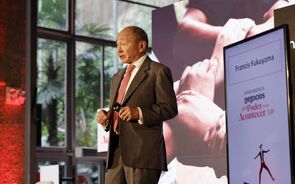13:30 Dados States
1 Mensagem
|Página 1 de 1
13:30 Dados States
8:29am 04/28/05 U.S. CONTINUING JOBLESS CLAIMS DOWN 76,000 TO 2.56 MLN
8:29am 04/28/05 U.S. 4-WEEK AVG. JOBLESS CLAIMS DOWN 8,000 TO 323,000
8:29am 04/28/05 U.S. WEEKLY JOBLESS CLAIMS UP 21,000 TO 320,000
8:30am 04/28/05 U.S. 1Q FINAL SALES UP 1.9%, SLOWEST IN 9 QUARTERS
8:30am 04/28/05 U.S. 1Q EQUIPMENT, SOFTWARE INVESTMENT UP 6.9%
8:30am 04/28/05 U.S. 1Q INVENTORY BUILDING ADDS 1.2% TO GDP
8:30am 04/28/05 U.S. GDP UP 3.6% YEAR-OVER-YEAR
8:30am 04/28/05 U.S. 1Q BUSINESS INVESTMENT RISES 4.7% VS. 14.5%
8:30am 04/28/05 U.S. 1Q CONSUMER SPENDING UP 3.5% VS. 4.2%
8:30am 04/28/05 U.S. 1Q CORE PCE PRICE INDEX UP 2.2% VS. 1.7%
8:30am 04/28/05 U.S. 1Q GDP SLOWEST GROWTH IN 2 YEARS
8:30am 04/28/05 U.S. 1Q GDP INCREASES 3.1% VS. 3.6% EXPECTED
ECONOMIC REPORT: U.S. 1Q GDP slows to 3.1%; Business investment slows, inflation heats up
By Rex Nutting, MarketWatch
Last Update: 8:31 AM ET April 28, 2005
WASHINGTON (MarketWatch) - The U.S. economy grew at a 3.1% seasonally adjusted annual rate in the first quarter of 2005, the slowest growth in two years, the Commerce Department estimated Thursday.
Consumer spending, inventory building and business investment contributed most of the increase in gross domestic product. Foreign trade was a drag on growth. The impact from government spending was negligible.
The economy grew 3.6% in the past year. GDP increased at a 3.8% rate in the fourth quarter.
Economists surveyed by MarketWatch were expecting GDP to increase 3.6% in the first quarter.
In current dollar terms, annualized GDP broke $12 trillion for the first time at $12.183 trillion.
Inflation heated up. Core consumer prices increased at a 2.2% rate in the quarter, leaving the year-over-year increase at 1.6%, near the top of the Federal Reserve's comfort zone.
Final sales of domestic product increased 1.9% in the first quarter, the weakest in nine quarters. Domestic purchases increased 4.4% after 5% in the fourth.
The slow growth and rising prices are certain to revive talk of stagflation, a troubling economic condition that combines the worst of both worlds and defies easy solutions.
For all the worry, however, growth in the first quarter was still close to or above trend, while inflation remained within the Fed's target.
The Federal Open Market Committee will meet on Tuesday to remove more stimulus from the economy. Most analysts believe the Fed will opt for an eighth straight quarter-point increase in interest rates, putting the federal funds rate at 3%.
Business investment slowed sharply from the fourth quarter, increasing 4.7% compared with 14.5%. Investments in equipment and software were the slowest in two years, rising 6.9% vs. 18.4% in the fourth quarter.
Investments in information technology were strong, offsetting a decline in transportation goods and weak investment in industrial equipment. Sales of computers added 0.56 percentage points to GDP.
Consumer spending slowed slightly, growing 3.5% in the first quarter after rising 4.2% in the fourth quarter. Spending on durable goods was flat. Spending on services accelerated.
Residential investments increased 5.7% in the first quarter after 3.4% in the fourth quarter.
Inventories grew by $80.2 billion, adding 1.2 percentage points to GDP, the largest contribution to growth in three years.
Meanwhile, the annualized trade deficit of $717.6 billion subtracted 1.5 percentage points from GDP, the largest drag on growth in two years. Exports increased 7%, while imports grew 14.7%.
Government spending increased 0.6%, the smallest gain in six quarters. Defense spending increased 0.2%.
Personal income increased 2.4% in the first quarter after a 10.9% gain in the fourth, which was boosted by the special one-time dividend from Microsoft. Real disposable incomes fell 0.3% in the first quarter.
ECONOMIC REPORT: U.S. jobless claims rise to 320,000; Increase in line with economists forecasts
By Greg Robb, MarketWatch
Last Update: 8:32 AM ET April 28, 2005
WASHINGTON (MarketWatch) - First-time claims for state unemployment benefits rebounded in the latest week after dropping to the lowest level for this business cycle in the previous week.
Initial claims rose 21,000 to a seasonally adjusted 320,000 in the week ending April 23, the Labor Department said Thursday.
The department could identify no special factors behind the increase, which was in line with the expectations of Wall Street economists.
The increase in claims in the latest week comes after a sharp drop in the previous week, where claims plunged 33,000 to 299,000.
A Labor Department official could not identify any single cause for the volatility in claims, but said one factor might be the Easter holiday.
As always, the government recommended looking at the four-week average as a more reliable indicator of labor market conditions.
The four-week moving average of initial claims, which smoothes out distortions caused by one-time events such as holidays, dropped by 8,000 to 323,000. It's the lowest level since the week ended March 19.
The insured unemployment rate - the ratio of beneficiaries to those eligible for benefits if laid off - fell to 2.0% in the week ended April 16 from 2.1% in the previous week. This is the lowest level in four years.
Meanwhile, the number of people receiving weekly benefit checks fell by 76,000 to 2.56 million in the week ended April 16. This is also the lowest level since March 19.
The four-week average of continuing claims fell 10,750 to 2.63 million, the lowest in four years.
8:29am 04/28/05 U.S. 4-WEEK AVG. JOBLESS CLAIMS DOWN 8,000 TO 323,000
8:29am 04/28/05 U.S. WEEKLY JOBLESS CLAIMS UP 21,000 TO 320,000
8:30am 04/28/05 U.S. 1Q FINAL SALES UP 1.9%, SLOWEST IN 9 QUARTERS
8:30am 04/28/05 U.S. 1Q EQUIPMENT, SOFTWARE INVESTMENT UP 6.9%
8:30am 04/28/05 U.S. 1Q INVENTORY BUILDING ADDS 1.2% TO GDP
8:30am 04/28/05 U.S. GDP UP 3.6% YEAR-OVER-YEAR
8:30am 04/28/05 U.S. 1Q BUSINESS INVESTMENT RISES 4.7% VS. 14.5%
8:30am 04/28/05 U.S. 1Q CONSUMER SPENDING UP 3.5% VS. 4.2%
8:30am 04/28/05 U.S. 1Q CORE PCE PRICE INDEX UP 2.2% VS. 1.7%
8:30am 04/28/05 U.S. 1Q GDP SLOWEST GROWTH IN 2 YEARS
8:30am 04/28/05 U.S. 1Q GDP INCREASES 3.1% VS. 3.6% EXPECTED
ECONOMIC REPORT: U.S. 1Q GDP slows to 3.1%; Business investment slows, inflation heats up
By Rex Nutting, MarketWatch
Last Update: 8:31 AM ET April 28, 2005
WASHINGTON (MarketWatch) - The U.S. economy grew at a 3.1% seasonally adjusted annual rate in the first quarter of 2005, the slowest growth in two years, the Commerce Department estimated Thursday.
Consumer spending, inventory building and business investment contributed most of the increase in gross domestic product. Foreign trade was a drag on growth. The impact from government spending was negligible.
The economy grew 3.6% in the past year. GDP increased at a 3.8% rate in the fourth quarter.
Economists surveyed by MarketWatch were expecting GDP to increase 3.6% in the first quarter.
In current dollar terms, annualized GDP broke $12 trillion for the first time at $12.183 trillion.
Inflation heated up. Core consumer prices increased at a 2.2% rate in the quarter, leaving the year-over-year increase at 1.6%, near the top of the Federal Reserve's comfort zone.
Final sales of domestic product increased 1.9% in the first quarter, the weakest in nine quarters. Domestic purchases increased 4.4% after 5% in the fourth.
The slow growth and rising prices are certain to revive talk of stagflation, a troubling economic condition that combines the worst of both worlds and defies easy solutions.
For all the worry, however, growth in the first quarter was still close to or above trend, while inflation remained within the Fed's target.
The Federal Open Market Committee will meet on Tuesday to remove more stimulus from the economy. Most analysts believe the Fed will opt for an eighth straight quarter-point increase in interest rates, putting the federal funds rate at 3%.
Business investment slowed sharply from the fourth quarter, increasing 4.7% compared with 14.5%. Investments in equipment and software were the slowest in two years, rising 6.9% vs. 18.4% in the fourth quarter.
Investments in information technology were strong, offsetting a decline in transportation goods and weak investment in industrial equipment. Sales of computers added 0.56 percentage points to GDP.
Consumer spending slowed slightly, growing 3.5% in the first quarter after rising 4.2% in the fourth quarter. Spending on durable goods was flat. Spending on services accelerated.
Residential investments increased 5.7% in the first quarter after 3.4% in the fourth quarter.
Inventories grew by $80.2 billion, adding 1.2 percentage points to GDP, the largest contribution to growth in three years.
Meanwhile, the annualized trade deficit of $717.6 billion subtracted 1.5 percentage points from GDP, the largest drag on growth in two years. Exports increased 7%, while imports grew 14.7%.
Government spending increased 0.6%, the smallest gain in six quarters. Defense spending increased 0.2%.
Personal income increased 2.4% in the first quarter after a 10.9% gain in the fourth, which was boosted by the special one-time dividend from Microsoft. Real disposable incomes fell 0.3% in the first quarter.
ECONOMIC REPORT: U.S. jobless claims rise to 320,000; Increase in line with economists forecasts
By Greg Robb, MarketWatch
Last Update: 8:32 AM ET April 28, 2005
WASHINGTON (MarketWatch) - First-time claims for state unemployment benefits rebounded in the latest week after dropping to the lowest level for this business cycle in the previous week.
Initial claims rose 21,000 to a seasonally adjusted 320,000 in the week ending April 23, the Labor Department said Thursday.
The department could identify no special factors behind the increase, which was in line with the expectations of Wall Street economists.
The increase in claims in the latest week comes after a sharp drop in the previous week, where claims plunged 33,000 to 299,000.
A Labor Department official could not identify any single cause for the volatility in claims, but said one factor might be the Easter holiday.
As always, the government recommended looking at the four-week average as a more reliable indicator of labor market conditions.
The four-week moving average of initial claims, which smoothes out distortions caused by one-time events such as holidays, dropped by 8,000 to 323,000. It's the lowest level since the week ended March 19.
The insured unemployment rate - the ratio of beneficiaries to those eligible for benefits if laid off - fell to 2.0% in the week ended April 16 from 2.1% in the previous week. This is the lowest level in four years.
Meanwhile, the number of people receiving weekly benefit checks fell by 76,000 to 2.56 million in the week ended April 16. This is also the lowest level since March 19.
The four-week average of continuing claims fell 10,750 to 2.63 million, the lowest in four years.
- Mensagens: 469
- Registado: 20/3/2005 22:23
1 Mensagem
|Página 1 de 1
Quem está ligado:
Utilizadores a ver este Fórum: acintra, Burbano, fosgass2020, Goya777, jprgodinho, latbal, malakas, MR32, nunorpsilva, O Magriço, PAULOJOAO, Pedro1974, SerCyc e 161 visitantes


